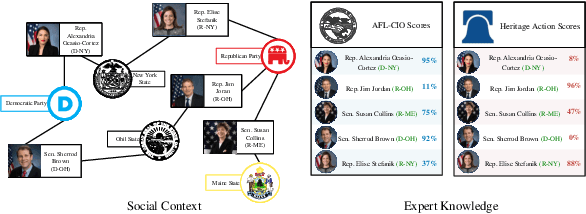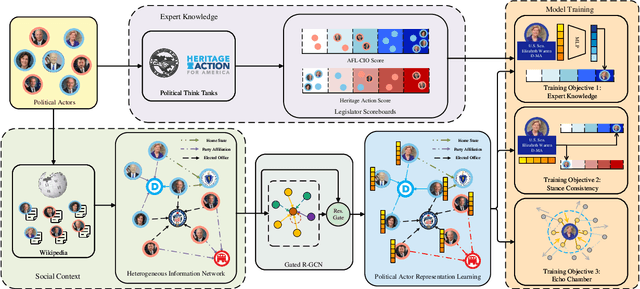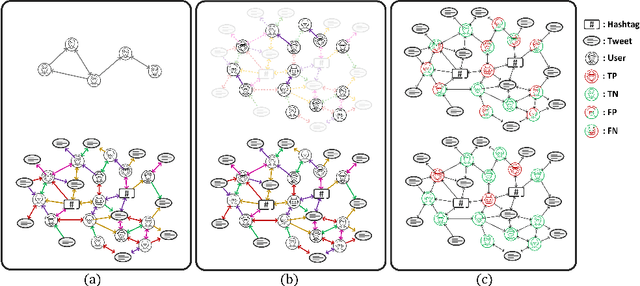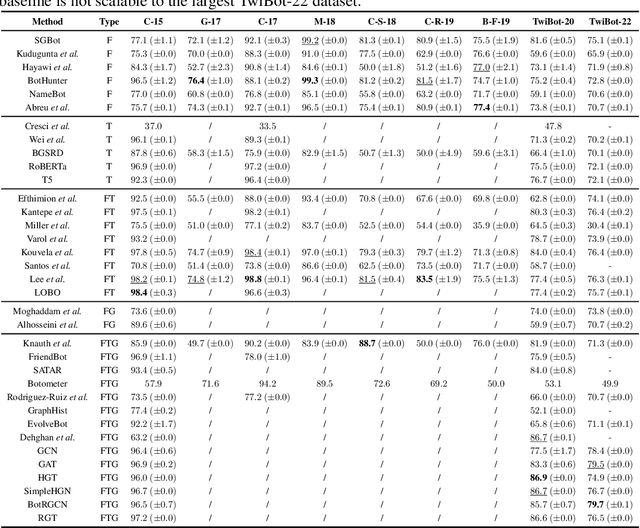Ningnan Wang
What Does the Bot Say? Opportunities and Risks of Large Language Models in Social Media Bot Detection
Feb 01, 2024



Abstract:Social media bot detection has always been an arms race between advancements in machine learning bot detectors and adversarial bot strategies to evade detection. In this work, we bring the arms race to the next level by investigating the opportunities and risks of state-of-the-art large language models (LLMs) in social bot detection. To investigate the opportunities, we design novel LLM-based bot detectors by proposing a mixture-of-heterogeneous-experts framework to divide and conquer diverse user information modalities. To illuminate the risks, we explore the possibility of LLM-guided manipulation of user textual and structured information to evade detection. Extensive experiments with three LLMs on two datasets demonstrate that instruction tuning on merely 1,000 annotated examples produces specialized LLMs that outperform state-of-the-art baselines by up to 9.1% on both datasets, while LLM-guided manipulation strategies could significantly bring down the performance of existing bot detectors by up to 29.6% and harm the calibration and reliability of bot detection systems.
PAR: Political Actor Representation Learning with Social Context and Expert Knowledge
Oct 15, 2022



Abstract:Modeling the ideological perspectives of political actors is an essential task in computational political science with applications in many downstream tasks. Existing approaches are generally limited to textual data and voting records, while they neglect the rich social context and valuable expert knowledge for holistic ideological analysis. In this paper, we propose \textbf{PAR}, a \textbf{P}olitical \textbf{A}ctor \textbf{R}epresentation learning framework that jointly leverages social context and expert knowledge. Specifically, we retrieve and extract factual statements about legislators to leverage social context information. We then construct a heterogeneous information network to incorporate social context and use relational graph neural networks to learn legislator representations. Finally, we train PAR with three objectives to align representation learning with expert knowledge, model ideological stance consistency, and simulate the echo chamber phenomenon. Extensive experiments demonstrate that PAR is better at augmenting political text understanding and successfully advances the state-of-the-art in political perspective detection and roll call vote prediction. Further analysis proves that PAR learns representations that reflect the political reality and provide new insights into political behavior.
TwiBot-22: Towards Graph-Based Twitter Bot Detection
Jun 12, 2022



Abstract:Twitter bot detection has become an increasingly important task to combat misinformation, facilitate social media moderation, and preserve the integrity of the online discourse. State-of-the-art bot detection methods generally leverage the graph structure of the Twitter network, and they exhibit promising performance when confronting novel Twitter bots that traditional methods fail to detect. However, very few of the existing Twitter bot detection datasets are graph-based, and even these few graph-based datasets suffer from limited dataset scale, incomplete graph structure, as well as low annotation quality. In fact, the lack of a large-scale graph-based Twitter bot detection benchmark that addresses these issues has seriously hindered the development and evaluation of novel graph-based bot detection approaches. In this paper, we propose TwiBot-22, a comprehensive graph-based Twitter bot detection benchmark that presents the largest dataset to date, provides diversified entities and relations on the Twitter network, and has considerably better annotation quality than existing datasets. In addition, we re-implement 35 representative Twitter bot detection baselines and evaluate them on 9 datasets, including TwiBot-22, to promote a fair comparison of model performance and a holistic understanding of research progress. To facilitate further research, we consolidate all implemented codes and datasets into the TwiBot-22 evaluation framework, where researchers could consistently evaluate new models and datasets. The TwiBot-22 Twitter bot detection benchmark and evaluation framework are publicly available at https://twibot22.github.io/
 Add to Chrome
Add to Chrome Add to Firefox
Add to Firefox Add to Edge
Add to Edge